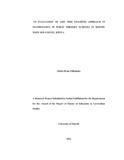| dc.description.abstract | Kenya continues to face high prevalence of unintended pregnancy. The Kenya 2014 Demographic and Health Survey (KDHS) demonstrated that 35% of the total pregnancies were unintended. The 2003 KDHS placed unintended pregnancy at 45% while the 2008-09 KDHS demonstrated that unintended pregnancies in Kenya were 43%. Mistimed pregnancies are quite high at more than 25% of the total pregnancies going by the 2014 KDHS. Unintended pregnancy (mistimed and unwanted pregnancy) is closely linked to adverse maternal and child health outcomes. In Kenya, it forms one of the key drivers of girl child school dropouts. Moreover, precarious termination of such pregnancies contributes hugely to maternal mortality which is currently estimated to be more than 362 deaths per 100 000 live births. No study has been done in Kenya to document the correlates of mistimed and unwanted pregnancy as separate concepts nationally. The paper used Multinomial Logit Model to analyze the determinants of unintended (mistimed and unwanted) pregnancy in Kenya. The findings indicate that women with Primary and secondary level of education and using modern and traditional contraceptives or intending to use any contraceptive in future have increased probability of having mistimed (wanted later) pregnancy compared to planned births. On the other hand, women who are currently working, in the age bracket of 20-34 and 35-49 years, classified as richer and richest, Muslim, currently married and had their first birth in the age bracket of 20-30 years are less likely to have mistimed pregnancy than pregnancy that is wanted then. Unwanted pregnancy (wanted no more) is on the other hand influenced positively by a woman having primary and secondary level of education, being in the age bracket of 35-49 years, urban residence, classified as middle and richer and using modern, traditional and intending to use any type of contraceptives sometimes in the future compared to wanted births. Women classified as poorer, of Muslim religion, currently married and have 1-2, 3-4, 5-6 and 7-8 children have a higher probability of experiencing unwanted pregnancy compared to planned births. | en_US |



